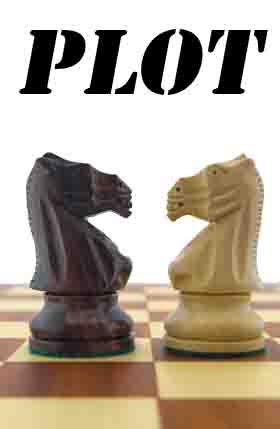Plot: 9 Ways of Looking at Plot
I’ve been thinking about plot and looking through my library of writing books to see the big picture of how plot is discussed and taught, how writers approach plot. It seems to me that the discussions fall into about 9 camps.
1. Plot equals character. This camp says that the characters and their problems will move the story. If you know your characters well enough, they will get into and out of scraps and fights and interesting problems. Usually, but not always, this is accompanied with the encouragement to just start writing and see where the character takes you.
 It seems to me that people who successfully write this way have a deeply ingrained, unconsciously competent, intuitive grasp of a story arc that includes a character facing his deepest fears and growing or changing some way as a result. As they write, they try to align the character with this inner sense of character. In Jack Bickham’s book, Scene & Structure, one appendix is of a Master Plot, detailing one particular way to conceive of the plot structure; authors who begin with character have an internal Master Plot of character.
It seems to me that people who successfully write this way have a deeply ingrained, unconsciously competent, intuitive grasp of a story arc that includes a character facing his deepest fears and growing or changing some way as a result. As they write, they try to align the character with this inner sense of character. In Jack Bickham’s book, Scene & Structure, one appendix is of a Master Plot, detailing one particular way to conceive of the plot structure; authors who begin with character have an internal Master Plot of character.
Those who are unsuccessful at this approach can create interesting characters who do interesting things, but they don’t key in to the deepest fears, don’t make the character suffer and change and grow.
Other readings about starting with character:
- Free Write to Let Characters Reveal Themselves
- Idea, Idea, Character, Character, Character, Setting
- Plot Starts with Character
2. Plot is a branching structure. If you start with a single statement, you can split it to two statements, and split that to four and that to eight and so on. Examples of proponents of this method are the Randy Ingermanson’s Snowflake Method, and How to Write a Damn Good Novel by James N. Frey.
Basically, you start with the Deep Theme (Snowflake) or Premise (Frey) which could describe the entire novel in a single sentence. Then you develop it by making it two (or three) sentences. Then each of those is divided into several sentences, 4-6 sentences. And so on.
The key to this is knowing, rather than discovering, the deep theme or premise. Some people start from the thinnest of threads and need those exploratory drafts to find out about character and theme. If you fall into this camp, then use Snowflaking as a revision strategy, instead of a first draft strategy.
More reading:
- If you like structured steps, or you want support for your first time plotting, you may like the Snowflake 10-step method.
- Outline by Snowflaking
3. Universal Plots. Some say there are only two plots in the world: a stranger comes to town or a character goes on a journey. Ronald Tobias’ book 20 Master Plots discusses some of the major universal plot schemes and generally lays out a structure for each; most helpful is when he designates some as character plots and others as action-oriented plots. For example the difference in a Quest and an Adventure is whether you focus on the inner or outer plot.
Other books in this vein are the classic from June & William Noble, Steal this Plot.
Or look at this 1916 book, which expresses the same idea of universality of plot:
4. Plot Patterns. Plot is a series of events that present the character with increasingly difficult choices until at the climax the conflict is resolved. This is the basic narrative arc you learned in high school. It may be enough to analyze a story by, but I’ve rarely seen it successful in leading a writer through the convolutions of plot.
However, there are patterns of plot which would fit the general idea of a narrative arc. The Hero’s Journey (orginally from Joseph Campbell, but best presented for writers by Christopher Vogler in The Writer’s Journey) establishes steps a character must face: call to action, denial, crossing the threshold, enemies & allies, approach to the inmost cave, supreme ordeal, reward, the road back, resurrection, return with elixir. John Vorhaus proposed a similar idea with his Comic Throughline in The Comic Toolbox.
I find this type pattern helpful because it fills in the smaller details left out by the English teacher’s description of plot. The Hero’s Journey is open-ended and general enough to allow for flexibility, while still being specific enough to point the writer in a useful direction. In other words, the English teacher’s plot says that the character faces a series of obstacles before reaching a final climax. The Hero’s Journey describes what some specific obstacles will look like AND it sequences those obstacles into an ideal timeline.
UPDATE:
Jerry Jenkins has an interesting 12 step method of outlining.
Books Mentioned in This Series
- Bickham, Jack. Scene & Structure
- Noble, June & William. Steal this Plot.
- Tobias, Ronald. 20 Master Plots
- Vogler, Christopher. The Writer’s Journey.
- Vorhaus, John. The Comic Toolbox.
Websites Mentioned in This Series
- Free Write to Let Characters Reveal Themselves
- Idea, Idea, Character, Character, Character, Setting
- Plot Starts with Character
- Randy Ingermanson’s Snowflake Method
Do you use one of these plot paradigms? Why that one?
Tomorrow: 4 more variations of plotting.
4 thoughts on “0”
Comments are closed.